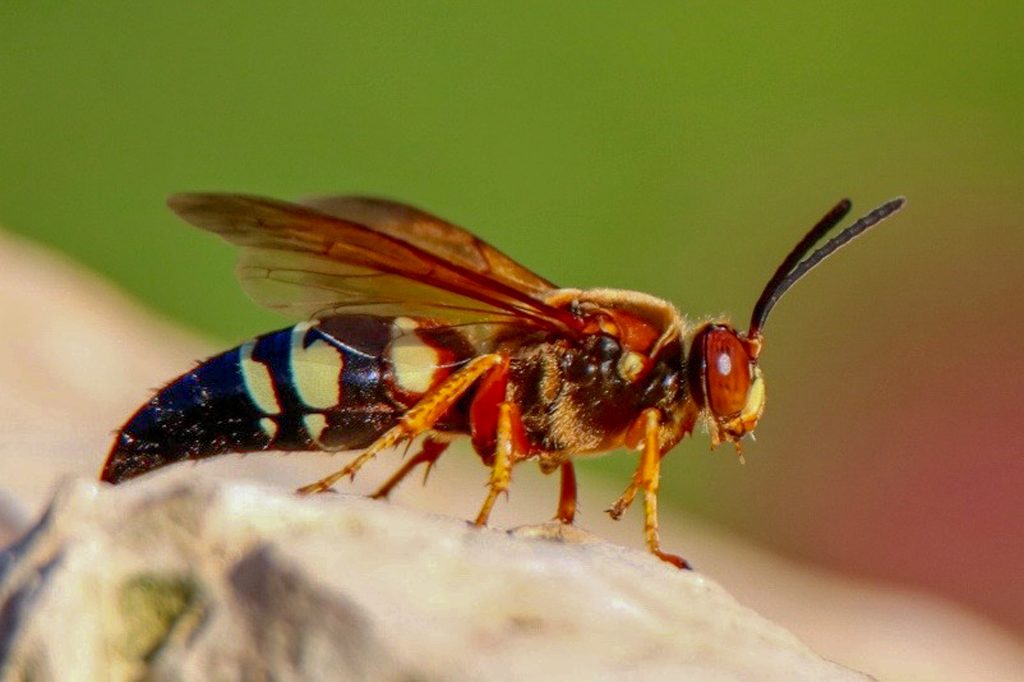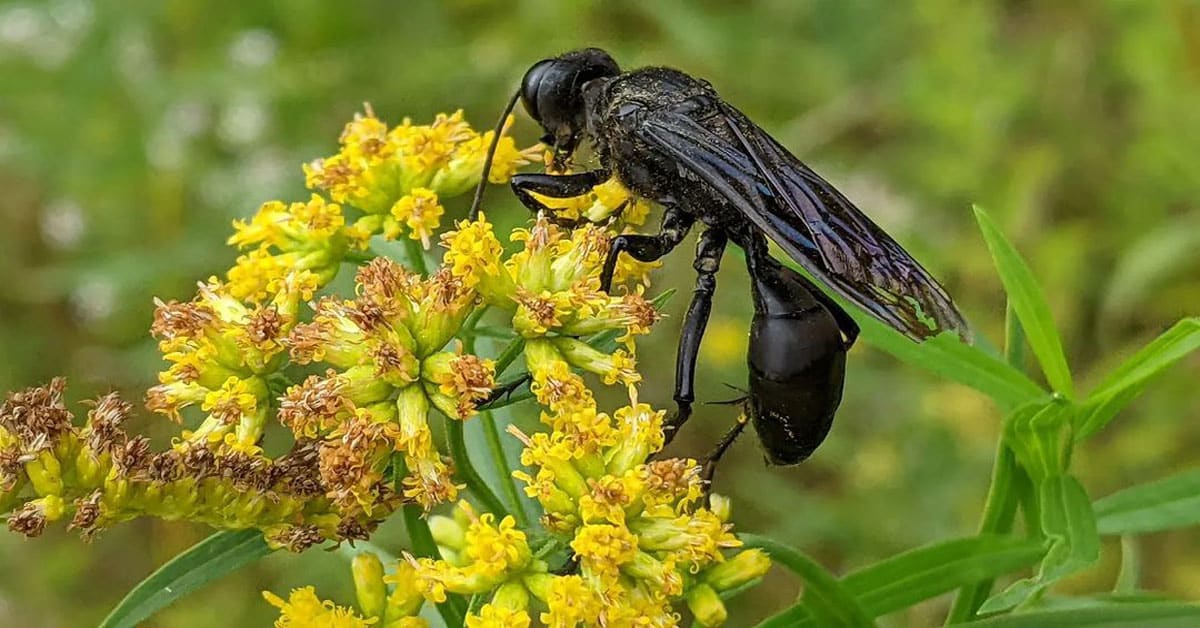Wasps are a common sight in America, and some of them can grow to be quite large. In this article, we will take a look at the top 7 largest wasps buzzing around America. The list includes species such as the Great Black Wasp, Long-Tailed Giant Ichneumonid Wasp, Cicada Killer, Tarantula Hawk, European Hornet, Great Golden Digger, and Northern Giant Hornet.
While some of these wasps are not aggressive and rarely sting humans, others can pose a danger to people and the bee population. In the following sections, we will provide more information about each of these wasps and their characteristics.
You are reading: Top 7 Largest Wasps Buzzing Around America

Top 7 Largest Wasps Buzzing Around America
Great Black Wasps

The Great Black Wasp (Sphex pensylvanicus) is a species of digger wasp that can be found across the majority of the United States except the Pacific Northwest. These wasps are approximately 22-28 millimeters in length and have a deep black body and wings with an iridescent blue sheen.
Great Black Wasps are solitary wasps with no hive or sister workers, and the females build their nests in the ground. They dig about a foot beneath the soil and create a series of tunnels using their mouth and spiny legs.
Each chamber is assigned an egg and a paralyzed insect to go with it. As soon as the larvae hatch, they will have a delicious meal to feed on as they develop.
The Great Black Wasps can commonly be found patrolling flowering plants during the summer, especially during July and August. They are not aggressive and rarely sting humans unless their nest is threatened.
Great Black Wasps are subterranean wasps, meaning they live underground and construct small underground nests where they care for their offspring. Their preferred habitat is open areas with flowers.
Long-Tailed Giant Ichneumonid Wasp

The Long-Tailed Giant Ichneumonid Wasp (Megarhyssa macrurus) is a species of large ichneumon wasp that belongs to the genus of giant ichneumons. The female wasp has a long ovipositor that can reach up to 4 inches in length, which it uses to deposit an egg into a tunnel in dead wood bored by its host, the larva of a similarly large species of horntail.
The wasp is harmless to humans and is a parasitoid on the larvae of the pigeon horntail (Tremex columba, Symphyta), which bore tunnels in decaying wood.
Read more : These Are The Top 4 Largest Beetles Crawling Around The U.S.
Female Long-Tailed Giant Ichneumonid Wasps are able to detect these larvae through the bark, paralyze them, and lay their eggs on the living but paralyzed larva. Within a couple of weeks, the wasp larvae will hatch and feed on the host larva until they are ready to pupate.
The Long-Tailed Giant Ichneumonid Wasp can be found on declining or recently dead hardwood trees between May and July. It parasitizes horntails present in declining trees but does not harm the tree itself.
Cicada Killer
The Cicada Killer (Sphecius speciosus) is a large, solitary digger wasp species in the family Crabronidae. It is also known as the Eastern Cicada Killer to differentiate it from other related wasp species.
Cicada Killers are approximately 2 inches in length and have a black body with yellow stripes across the middle section and the first three segments of the rear section of the abdomen. The head and parts of the thorax are a dull red, and all six legs are brightly colored orangish-red.
Cicada Killers are not aggressive and pose little threat to humans, although their large size and loud buzzing can be intimidating. Male Cicada Killers are territorial and will defend their territory against other insects, but they cannot sting humans.
Female Cicada Killers feed on tree sap and flower nectar, and they hunt cicadas as food for their offspring. They strike and stun the cicada, which reacts with a loud shrieking buzz, and then use their stinger to paralyze the cicada before carrying it to their underground nest.
Cicada Killers can be found in open areas such as lawns, pastures, and meadows, and they are active from late June or July. Control measures are seldom required because Cicada Killers are beneficial insects that help control cicada populations.
Tarantula Hawk
The Tarantula Hawk is a type of spider wasp belonging to the family Pompilidae. They are one of the largest parasitoid wasps, using their sting to paralyze their prey before dragging it to a brood nest as living food.
Tarantula Hawks are found on all continents except Antarctica, and they are restricted to the Americas. The female wasp hunts tarantulas, which it uses as food for its larvae.
The wasp will paralyze the tarantula with its stinger and then transport the spider back to the hawk’s nest. Once there, the female lays an egg in the spider’s abdomen, then covers the nest with soil. When the egg hatches, the wasp larva feeds on the still-living tarantula until it is ready to pupate.
Tarantula Hawks are approximately 2 inches in length and have dark blue, iridescent bodies, bright orange wings, and long legs. Males have straight antennae, while females have curly antennae.
Adult Tarantula Hawks are nectarivorous and feed on flowers, but they can become intoxicated by fermented fruit, which can make it difficult for them to fly. They are most active during the daytime in summer but tend to avoid high temperatures.
The sting of the Tarantula Hawk is considered to be one of the most painful insect stings, with a pain level that is compared to being stunned with a taser.
European Hornet
Read more : Discover The 3 Types Of Rattlesnakes In Nebraska
The European Hornet (Vespa crabro) is the largest eusocial wasp native to Europe. It is also the only true hornet found in North America, having been introduced to the United States and Canada from Europe as early as 1840.
Here are some key facts about the European Hornet:
Identification:
– Brown with yellow abdominal stripes and pale face
– Long, robust, wasp-like body
– Approximately 3/4 to 1 3/8 inches long
Distribution:
– Native to Europe and Asia
– Introduced to North America in the 1840s
– Currently found from the eastern seaboard west to the eastern Dakotas and south through Iowa and Illinois to New Orleans
Behavior:
– Social insects that live in colonies that may contain between 200-400 members at their peak
– Prey on a variety of large insects such as grasshoppers, flies, yellow jackets, and honeybees
– Help control insects that would otherwise become pests
– Nests in common areas such as hollow trees, attics, porches, and inside wall voids
– Seeing large worker European hornets is a sign of infestation
European hornets are not typically aggressive and will only sting if their nest is threatened. However, their sting can be painful and may cause an allergic reaction in some people. If you suspect that you have a European Hornet infestation, it is best to contact a pest control professional for removal.
Great Golden Digger
The Great Golden Digger Wasp (Sphex ichneumoneus) is a species of solitary wasp that belongs to the family Sphecidae. Here are some key facts about the Great Golden Digger Wasp:
Identification:
– Approximately 1/2 to 1 inch in length
– Black head and thorax covered with short, golden hair
– Reddish-orange legs and front abdomen
– Black rear segment of the abdomen
Behavior:
– Solitary wasps that live in underground burrows
– Females construct burrows with a descending shaft and individual brood chambers arranged at right angles to it
– Prey on a variety of insects, including grasshoppers, crickets, and katydids
– Paralyze their prey with a venomous sting and drag them to their burrow
– Lay an egg on the paralyzed prey and seal the brood chamber
– Larvae feed on the still-living prey until they are ready to pupate
Great Golden Digger Wasps are gentle and solitary, preferring to retreat rather than attack a potential threat. They are beneficial insects that help control insect populations and aerate the soil. Great Golden Digger Wasps are found throughout Missouri and Florida, and their range extends across most of the eastern United States.
Northern Giant Hornet
The Northern Giant Hornet (Vespa mandarinia), also known as the Asian giant hornet, is the largest hornet species in the world. Here are some key facts about the Northern Giant Hornet:
Identification:
– Queens are among the largest wasps in the world and can grow in excess of 2 inches with a wingspan of 3 inches
– Large orange head with prominent eyes
– Black and orange/yellow striped abdomen
– Usually 1.5 – 2 inches in length
Distribution:
– Native to temperate and tropical East Asia, South Asia, Mainland Southeast Asia, and parts of the Russian Far East
– Found in the Pacific Northwest of North America in late 2019 with a few more additional sightings in 2020, and nests found in 2021
– Concerns have been raised that it could become an invasive species in North America
Behavior:
– Social wasp species that lives in colonies
– Builds its nest underground, which makes locating and removing the nest a challenge
– Preys on honeybees, other insects, and even other hornet species
– Can pose a threat to humans if their nest is disturbed
The Northern Giant Hornet is a concern for beekeepers and agricultural officials because of its potential impact on honeybee populations.
However, it is important to note that the Northern Giant Hornet is not typically aggressive towards humans unless their nest is threatened. If you suspect that you have a Northern Giant Hornet infestation, it is best to contact a pest control professional for removal.
FAQS
1. What are the top 7 largest wasps buzzing around America?
The top 7 largest wasps buzzing around America are the Great Black Wasp, Long-Tailed Giant Ichneumonid Wasp, Cicada Killer, Tarantula Hawk, European Hornet, Great Golden Digger, and Northern Giant Hornet.
2. Are these wasps dangerous to humans?
Most of these wasps are not aggressive towards humans and pose little threat unless their nest is threatened. However, some species, such as the Northern Giant Hornet and Tarantula Hawk, can pose a threat to humans if their nest is disturbed.
3. What do these wasps eat?
These wasps have different diets depending on the species. Some, like the Cicada Killer and Great Golden Digger, prey on insects, while others, like the European Hornet, feed on nectar and tree sap.
4. Where do these wasps live?
These wasps have different habitats depending on the species. Some, like the Great Black Wasp and Great Golden Digger, live in underground burrows, while others, like the European Hornet, build papery nests in hollow trees or under eaves.
5. How can I get rid of these wasps if they become a problem?
If you suspect that you have a wasp infestation, it is best to contact a pest control professional for removal. It is important to note that some of these wasps are beneficial insects that help control insect populations, so it is best to avoid eradicating them entirely unless necessary.
Source: https://petstutorial.com
Category: Animals










